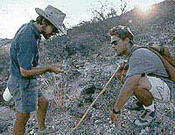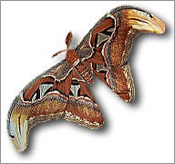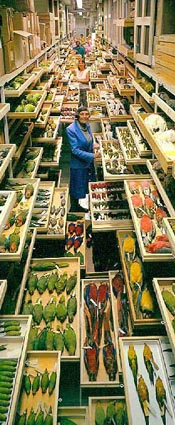Research & Collections
Science Departments
Projects & Resources
Professional & Academic Services
Behind the Scenes:
NMNH Research and Collections
Beyond the Museum’s exhibitions lies a labyrinth of hallways, vast storage rooms and busy offices, all filled with the sights and sounds of discovery.
Eminent scientists, specimens, books and papers microscopes, and sophisticated computer systems: Welcome to the realm of NMNH Research and Collections. In this university-like atmosphere, scientists delve deep into the history of our planet and the processes and peoples that shape it today.
Their enduring curiosity has led these Museum explorers to the four corners of the earth. They travel to ocean depths, the peaks of the Andes, Africa's Rift Valley, the rainforests of South America, and the deserts of Central Asia. Perhaps even to a field site or research institution in your own state, territory or country.

- Paleoanthropologist Rick Potts (left) and post-doctoral fellow Mike Noll at Olorgesailie, Kenya, seeking clues to the beginnings of human history. Photo by Chip Clark.
In each area, researchers collect specimens: fossils, minerals, and rocks, plants and animals, tools and artworks. Collections care professionals have meticulously preserved, labeled, catalogued, and organized items of this kind for more than 150 years.
Taken together, the NMNH collections form the largest, most comprehensive natural history collection in the world. By comparing items gathered in different eras and regions, scientists learn how our world has varied across time and space.
Such collections-based research then provides the essential building blocks for answering broader questions about our future. NMNH scientists and their colleagues worldwide seek the puzzle pieces that will form detailed pictures of vital topics such as evolutionary relationships of organisms, biodiversity loss and global climate change.
The Museum’s location in the heart of the nation’s capital promotes sharing these research findings with key decisionmakers from around the world.

- Atlas Moth from the family Saturniidae. Photo by Chip Clark.
There are now over 126 million items in the ever-growing NMNH collections, ranging from fossilized pollen to bones of Tyrannosaurus rex, algal samples to a slab of a giant sequoia tree, tiny crustaceans to giant squid, DNA samples to whale skulls, ancient spear points to Chinese shoes, and the Hope Diamond to Moon rocks.
Museum visitors sometimes wonder aloud whether we need to keep adding “stuff” to the NMNH collections. In fact, we have literally only skimmed the surface when it comes to understanding the natural world and humanity’s place in it.
We could no more finish adding specimens to the National Collections of the Smithsonian Institution than we could stop adding books to the Library of Congress or historic documents to the National Archives! Together, these are among our nation's greatest treasures.
Recent NMNH Research Activities

Scientists are studying the products of the most recent eruptions of Ecuador’s Tungurahua volcano. By analyzing mineral and glass compositions, they aim to determine the explosive potential of the next big eruption. Pictured: Ecuador’s Tungurahua volcano.

At the February 2006 AAAS meeting, Smithsonian Paleobiologist Scott Wing updated results of his November 11 cover story in Science. A team led by Wing found that a period of rapid global warming 55 million years ago caused major changes in where plants grew. Pictured: Fossil leaf from the earliest Eocene (~55.5 million years) of the Bighorn Basin, Wyoming.

Studies of the rich diversity of plants and animals in the remote Guiana Shield region of South America help identify the areas most in need of preservation. Unlike other nearby regions, over 70% of the natural habitat here remains pristine. These areas are now threatened by increased resource extraction. Pictured: Cattleya violacea (Kunth) Rolfe, Orchidaceae.

Travels back through time help unravel the mystery of human origins. A combination of archeological, ecological, and geological theories and techniques is unveiling the ecosystems in which early humans lived, the plants and animals that shared these environments, and the changes that have occurred over the last few million years. Illustrated: Kennewick Man skull.

Florida's Indian River Lagoon is the most diverse estuary on the east coast of the United States. By documenting the flora and fauna of the lagoon, scientists are beginning to understand the interactions of the area's inhabitants, whether they are humans (fishermen, residents, pleasure boaters) or manatees, dolphins, fishes and invertebrates. Pictured: Dolphins cavort in the bow wake of the Smithsonian Tropical Research Institute's oceangoing research vessel, the RV Benjamin.
[ TOP ]
